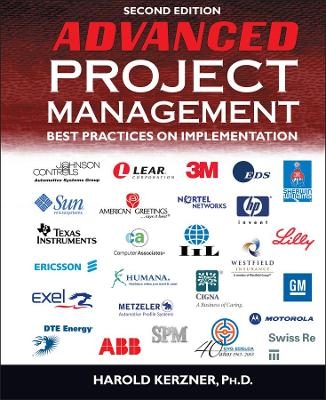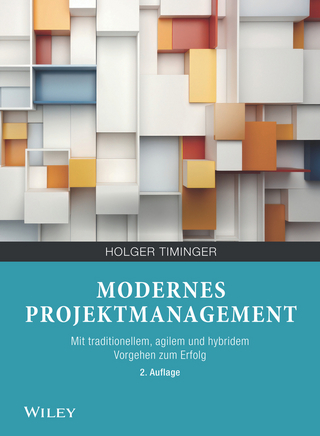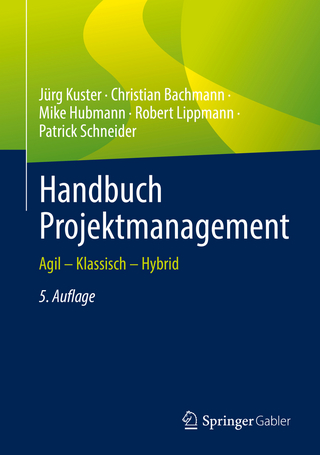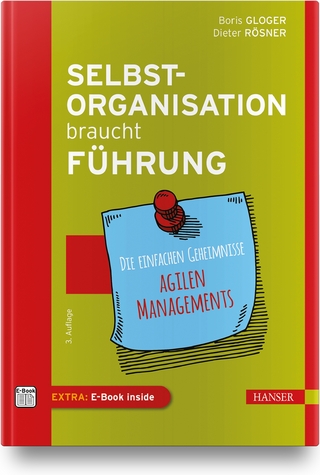
Advanced Project Management
John Wiley & Sons Inc (Verlag)
978-0-471-47284-1 (ISBN)
- Titel z.Zt. nicht lieferbar
- Versandkostenfrei innerhalb Deutschlands
- Auch auf Rechnung
- Verfügbarkeit in der Filiale vor Ort prüfen
- Artikel merken
ADVANCED PROJECT MANAGEMENT AUTHORITATIVE STRATEGIES FOR IMPLEMENTING PROJECT MANAGEMENT
Senior managers at world-class corporations open their office doors to discuss case studies that demonstrate their thought processes and actual strategies that helped them lead their companies to excellence in project management in less than six years!
Following the Project Management Institute’s Body of Knowledge (PMBOK®), industry leaders address:
Project risk management
Project portfolio management
The Project Office
Project management multinational cultures
Integrated project teams and virtual project teams
HAROLD KERZNER, PH.D., is Professor of Systems Management at Baldwin-Wallace College in Ohio and President of Project Management Associates, a consulting and training firm that conducts seminars for leading U.S. and international corporations.
Preface xv
1 The Growth of Project Management 1
1.0 Introduction 1
1.1 Understanding Project Management 1
1.2 Resistance to Change 4
1.3 Strategic Imperatives for Project Management 9
1.4 Project Management Life Cycle 13
1.5 Excellence in Project Management 16
1.6 Selection of Companies as Examples 18
Multiple Choice Questions 22
Discussion Questions 25
Crossword 27
2 Success, Maturity, And Excellence: Definitions 29
2.0 Introduction 29
2.1 Early Definitions of Success 29
2.2 Modern Definitions of Success 30
2.3 Project Management Maturity 34
2.4 Critical Success Factors in Project Management 42
2.5 Definition of Excellence 43
2.6 Best Practices in Project Management 46
2.7 A Structured Approach 46
2.8 Myths 56
Multiple Choice Questions 57
Discussion Questions 60
Crossword 61
3 The Driving Forces for Maturity 63
3.0 Introduction 63
3.1 Capital Projects 64
3.2 Customers’ Expectations 65
3.3 Competitiveness 73
3.4 Executive Managers’ Buy-In 75
3.5 New Product Development 79
3.6 Efficiency and Effectiveness 81
3.7 Company Survival 83
3.8 Other Driving Forces 88
Multiple Choice Questions 88
Discussion Questions 92
Crossword 93
4 Project Management Methodologies 95
4.0 Introduction 95
4.1 Examples of Methodology Development 96
4.2 Overcoming Development and Implementation Barriers 105
4.3 Critical Components 114
4.4 Benefits of a Standard Methodology 124
4.5 Implementing the Methodology 132
4.6 Project Management Tools 142
Multiple Choice Questions 147
Discussion Questions 150
Crossword 151
5 Strategic Planning for Excellence in Project Management 153
5.0 Introduction 153
5.1 Influence of Economic Conditions 153
5.2 What Is General Strategic Planning? 156
5.3 What Is Strategic Planning for Project Management? 157
5.4 Critical Success Factors for Strategic Planning 163
5.5 Identifying Strategic Resources 171
5.6 Strategic Selection of Projects 175
5.7 Horizontal Accounting 179
5.8 Continuous Improvement 181
5.9 Why Does Strategic Planning for Project Management Fail? 186
5.10 Strategic Planning in Action 188
5.11 Organizational Restructuring 191
5.12 Career Planning 192
5.13 The Project Management Maturity Model 193
5.14 How to Conduct a PM Maturity Assessment 197
Multiple Choice Questions 208
Discussion Questions 211
Crossword 213
6 The Maturity of Modern Project Management 215
6.0 Introduction 215
6.1 Classification of Changes 215
6.2 Classification of Companies 217
6.3 Recessionary Effects 219
6.4 Global Pressures 220
6.5 Concurrent Engineering 222
6.6 Project Objectives 224
6.7 Definition of Success 225
6.8 Velocity of Change 226
6.9 Management Style 227
6.10 Authority and Job Descriptions 228
6.11 Evaluation of Team Members 229
6.12 Accountability 230
6.13 Project Management Skills 231
6.14 Planning Hours/Dollars 234
6.15 Education and Training 235
6.16 Project Sponsorship 236
6.17 Project Failures 237
6.18 Maturity and Immaturity 238
Multiple Choice Questions 239
Discussion Questions 242
Crossword 243
7 Project Portfolio Management 245
7.0 Introduction 245
7.1 Involvement of Senior Management and Stakeholders 246
7.2 Project Selection Obstacles 248
7.3 Identification of Projects 249
7.4 Preliminary Evaluaiton 253
7.5 Strategic Selection of Projects 254
7.6 Strategic Timing 257
7.7 Analyzing the Portfolio 258
7.8 Problems with Meeting Expectations 259
Multiple Choice Questions 263
Discussion Questions 265
Crossword 267
8 The Project Office 269
8.0 Introduction 269
8.1 The Project Office: 1950–1990 269
8.2 The Project Office: 1990–2000 270
8.3 The Project Office: 2000–Present 272
8.4 Types of Project Offices 278
8.5 Project Management Information Systems 298
8.6 Dissemination of Information 306
8.7 Mentoring 306
8.8 Development of Standards and Templates 307
8.9 Project Management Benchmarking 308
8.10 Business Case Development 309
8.11 Customized Training (Related to Project Management) 310
8.12 Managing Stakeholders 313
8.13 Continuous Improvement 314
8.14 Capacity Planning 316
8.15 Risks of Using a Project Office 317
8.16 Project Office Excellence: A Case Study of Johnson Controls, Inc. (JCI) Automotive Systems Group (ASG) 318
8.17 Reporting and Structure 321
Multiple Choice Questions 322
Discussion Questions 324
Crossword 325
9 Integrated Processes 327
9.0 Introduction 327
9.1 Understanding Integrated Management Processes 327
9.2 Evolution of Complementary Project Management Processes 329
9.3 Total Quality Management 333
9.4 Concurrent Engineering 335
9.5 Risk Management 336
9.6 Change Management 350
9.7 Other Management Processes 352
9.8 Integrated Processes at Work 352
Multiple Choice Questions 359
Discussion Questions 362
Crossword 364
10 Culture 365
10.0 Introduction 365
10.1 Creation of a Corporate Culture 366
10.2 Corporate Values 375
10.3 Types of Cultures 380
10.4 Shared Accountability and Multiple-Boss Reporting 381
10.5 Shared Rewards 382
10.6 Prioritization of Work 383
10.7 Corporate Cultures at Work 383
Multiple Choice Questions 396
Discussion Questions 400
Crossword 401
11 Management Support 403
11.0 Introduction 403
11.1 Visible Support from Senior Managers 403
11.2 Project Sponsorship 404
11.3 Excellence in Project Sponsorship 408
11.4 Empowerment of Project Managers 409
11.5 Management Support at Work 412
Multiple Choice Questions 414
Discussion Questions 417
Crossword 418
12 Training and Education 419
12.0 Introduction 419
12.1 Training for Modern Project Management 420
12.2 Identifying the Need for Training 426
12.3 Selecting the Students 427
12.4 Fundamentals of Project Management Education 427
12.5 Designing the Courses and Conducting the Training 428
12.6 Measuring the Return on Investment 432
12.7 Competency Models 434
12.8 Training and Education at Work 450
Multiple Choice Questions 456
Discussion Questions 459
Crossword 460
13 Informal Project Management 461
13.0 Introduction 461
13.1 Informal versus Formal Project Management 461
13.2 Trust 464
13.3 Communication 465
13.4 Cooperation 469
13.5 Teamwork 469
13.6 Color-Coded Status Reporting 470
13.7 Informal Project Management at Work 472
Multiple Choice Questions 474
Discussion Questions 476
Crossword 478
14 Behavioral Excellence 479
14.0 Introduction 479
14.1 Situational Leadership 479
14.2 Conflict Resolution 482
14.3 Staffing for Excellence 484
14.4 Integrated Product/Project Teams 486
14.5 Virtual Project Teams 494
14.6 Rewarding Project Teams 496
14.7 Keys to Behavioral Excellence 499
Multiple Choice Questions 502
Discussion Questions 505
Crossword 507
15 The Effect of Mergers and Acquisitions on Project Management 509
15.0 Introduction 509
15.1 Planning for Growth 509
15.2 The Project Management Value-Added Chain 510
15.3 Preacquisition Decision-Making 513
15.4 Landlords and Tenants 519
15.5 Best Practices: A Case Study on Johnson Controls, Inc. 520
15.6 Integration Results 524
15.7 Value Chain Strategies 526
15.8 Failure and Restructuring 528
Multiple Choice Questions 529
Discussion Questions 531
Crossword 533
16 Rising Stars and Future Directions 535
16.0 Introduction 535
16.1 Computer Associates 535
16.2 Lear 549
16.3 Texas Instruments 555
16.4 Sun Microsystems 560
16.5 Motorola System Solution Group 571
16.6 Nortel Networks 573
16.7 Battelle Memorial Institute 574
16.8 Johnson Controls 576
16.9 Metzeler Automotive Profile System 579
16.10 EDS 583
16.11 USAA 585
16.12 Changing Times 586
Appendixes 591
A: Quality Awards at Johnson Controls Automotive Systems Group 591
B: Project Management Maturity Questionnaire 595
C: Project Management Excellence Questionnaire 599
D: Software Development Methodology at Computer Associates 609
E: Best Practices Library Development at Computer Associates 617
F: Post Project Assessment Process at Computer Associates 631
Case Studies 637
Case 1: Clark Faucet Company 637
Case 2: Photolite Corporation (A) 640
Case 3: Photolite Corporation (B) 642
Case 4: Photolite Corporation (C) 645
Case 5: Photolite Corporation (D) 650
Case 6: Continental Computer Corporation 655
Case 7: Goshe Corporation 659
Case 8: Hyten Corporation 664
Case 9: Acorn Industries 674
Case 10: Mohawk National Bank 680
Case 11: First Security Bank of Cleveland 683
Case 12: Como Tool and Die (A) 686
Case 13: Como Tool and Die (B) 689
Case 14: Apache Metals, Inc. 691
Case 15: Cordova Research Group 693
Case 16: Cortez Plastics 694
Case 17: Haller Specialty Manufacturing 695
Case 18: Macon, Inc. 696
Case 19: Jones and Shephard Accountants 698
Case 20: The Trophy Project 701
Case 21: The Blue Spider Project 704
Case 22: Corwin Corporation 716
Case 23: Denver International Airport 725
Case 24: MIS Project Management at First National Bank 757
Case 25: Concrete Masonry Corporation 767
Case 26: Construction of a Gas Testing Laboratory in Iran 774
Case 27: The Space Shuttle Challenger Disaster 781
Case 28: Phillip Condit and the Boeing 777: From Design and Development to Production and Sales 819
Index 839
| Erscheint lt. Verlag | 6.1.2004 |
|---|---|
| Zusatzinfo | Drawings: 165 B&W, 0 Color; Tables: 40 B&W, 0 Color; Exhibits: 44 B&W, 0 Color |
| Verlagsort | New York |
| Sprache | englisch |
| Maße | 193 x 239 mm |
| Gewicht | 1624 g |
| Einbandart | gebunden |
| Themenwelt | Technik |
| Wirtschaft ► Betriebswirtschaft / Management ► Projektmanagement | |
| ISBN-10 | 0-471-47284-0 / 0471472840 |
| ISBN-13 | 978-0-471-47284-1 / 9780471472841 |
| Zustand | Neuware |
| Haben Sie eine Frage zum Produkt? |
aus dem Bereich


